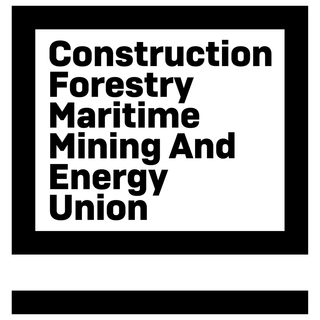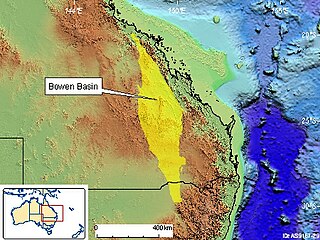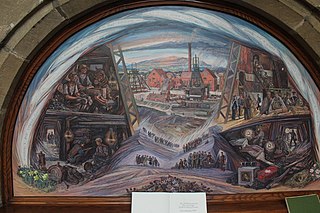A mining accident is an accident that occurs during the process of mining minerals. Thousands of miners die from mining accidents each year, especially from underground coal mining, although hard rock mining is not immune from accidents. Coal mining is considered much more hazardous than hard rock mining due to flat-lying rock strata, generally incompetent rock, the presence of methane gas, and coal dust. Most of the deaths these days occur in developing countries, and rural parts of developed countries.

Central Queensland is an ambiguous geographical division of Queensland that centres on the eastern coast, around the Tropic of Capricorn. Its major regional centre is Rockhampton. The region extends from the Capricorn Coast west to the Central Highlands at Emerald, north to the Mackay Regional Council southern boundary, and south to Gladstone. The region is also known as Capricornia. It is one of Australia's main coal exporting regions.

Moura is a small town and locality in the Shire of Banana in Central Queensland, Australia. It services the surrounding coal mining and rural activities. It is situated approximately 65 kilometres (40 mi) west of Biloela on the Dawson Highway, 186 kilometres (116 mi) west of the port city of Gladstone, and 171 kilometres (106 mi) south west of Rockhampton. At the 2011census, Moura had a population of 1,899 people.

The Construction, Forestry, Maritime, Mining and Energy Union is Australia's main trade union in construction, forestry, maritime, mining, energy, textile, clothing and footwear production. The CFMMEU is affiliated with the Australian Council of Trade Unions, with the Australian Labor Party and with the World Federation of Trade Unions.

The Mount Mulligan mine disaster occurred on 19 September 1921 in Mount Mulligan, Far North Queensland, Australia. A series of explosions in the local coal mine, audible as much as 30 km away, rocked the close-knit township.

Mining in Australia has long been a significant primary industry and contributor to the Australian economy by providing export income, royalty payments and employment. Historically, mining booms have also encouraged population growth via immigration to Australia, particularly the gold rushes of the 1850s. Many different ores, gems and minerals have been mined in the past and a wide variety are still mined throughout the country. Most of what is mined is exported with relatively little processing done within Australia.

Scottville is a small town and locality in the Whitsunday Region, Queensland, Australia. In the 2011 census, Scottvile had a population of 344 people.

The Bowen Basin contains the largest coal reserves in Australia. This major coal-producing region contains one of the world's largest deposits of bituminous coal. The Basin contains much of the known Permian coal resources in Queensland including virtually all of the known mineable prime coking coal. It was named for the Bowen River, itself named after Queensland's first Governor, Sir George Bowen.

Balmain Colliery was a coal mine located in Birchgrove in the inner-west of Sydney, in the state of New South Wales, Australia. It produced coal from 1897 until 1931 and natural gas until 1945. At approximately 880 m depth, it remains the deepest coal mine ever to have been sunk in Australia.

The Knockshinnoch Disaster is a mining accident that occurred in the Ayrshire village of New Cumnock in September 1950. A glaciated lake filled with liquid peat and moss flooded pit workings trapping more than a hundred miners underground. For several days rescue teams worked non-stop to reach the trapped men. Most were eventually rescued three days later. However, 13 were killed. The disaster was an international media event.

Gresford Colliery was a coal mine located a mile from the North Wales village of Gresford, near Wrexham.

Queensland's railway construction commenced in 1864, with the turning of the first sod of the Main Line by Lady Diamantina Bowen, the wife of Queensland's first governor Sir George Bowen at Ipswich, Queensland, Australia. A narrow gauge of 3 ft 6 in was selected due to cost savings in providing a rail link to Toowoomba. Despite being built with bridges wide enough for standard gauge, and the fact that most other lines did not require heavy earthworks, the gauge remained the Queensland system norm.

The Pike River Mine disaster was a coal mining accident that began on 19 November 2010 in the Pike River Mine, 46 kilometres (29 mi) northeast of Greymouth, in the West Coast region of New Zealand's South Island. A methane explosion occurred in the mine at approximately 3:44 pm. At the time of the explosion 31 miners and contractors were present in the mine. Two miners managed to walk from the mine; they were treated for moderate injuries and released from Greymouth Hospital the next day. The remaining 16 miners and 13 contractors were believed to be at least 1.5 kilometres (1,600 yd) from the mine's entrance.

The Moranbah North Coal Mine is a coal mine in the Bowen Basin at Moranbah in Central Queensland, Australia. The mine has coal reserves amounting to 261 million tonnes of coking coal, one of the largest coal reserves in Asia and the world. The mine has an annual production capacity of 8 million tonnes of coal. Most of the coal is exported and used to produce iron and steel in Asia but also to India, Brazil and Europe via the Goonyella railway line to Hay Point.

The Torbanlea Colliery Disaster was a 1900 mining accident near the town of Torbanlea in the colony of Queensland that claimed the lives of five workers. The accident prompted a Royal Commission into mining practices within Queensland.

Collinsville Cemetery is a heritage-listed cemetery at Collinsville-Scottville Road, Collinsville, Whitsunday Region, Queensland, Australia. It was built from 1927 onwards. It is also known as Collinsville-Scottville Cemetery. It was added to the Queensland Heritage Register on 18 September 2009.

The Bowen Basin Coalfields contains the largest coal reserves in Australia. This major coal-producing region contains one of the world's largest deposits of bituminous coal. The Basin contains much of the known Permian coal resources in Queensland including virtually all of the known mineable prime coking coal. It was named for the Bowen River, itself named after Queensland's first Governor, Sir George Bowen.




















